MARIANI’S
Virtual
Gourmet
SEPTEMBER 29,
2019
NEWSLETTER
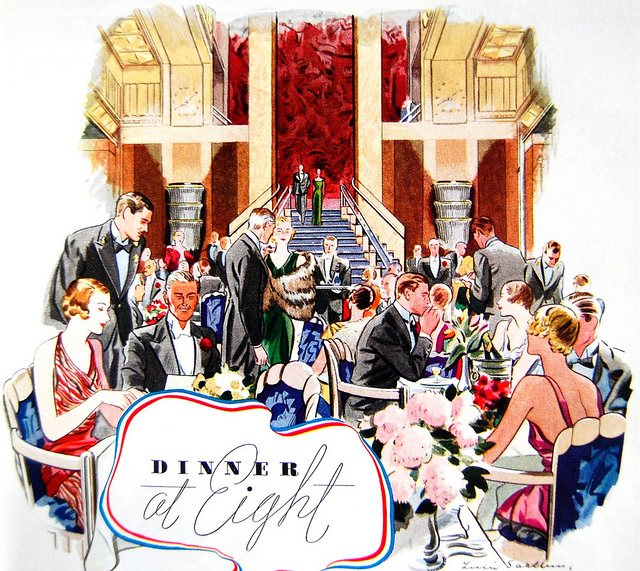
❖❖❖
IN THIS ISSUE
SEDONA AT THE CROSSROADS
By John Mariani
NEW YORK CORNER
NORA THAI
By John Mariani
NOTES FROM THE WINE CELLAR
CAMERON HUGHES AND
THE ALLOCATION SHUFFLE
By John Mariani
❖❖❖
SEDONA AT THE
CROSSROADS
By John Mariani

Photo by John Mariani
Wordsworth
wrote of London, “earth hath not anything to
show more fair.” But then, he’d never been to
Sedona, Arizona.
Arizona has been blessed with extraordinary
natural wonders—the Grand Canyon, Monument Valley,
Havasu Falls, the Petrified Forest, Sagauro
National Park—along with unique man-made marvels
like Hoover Dam and the Native American cliff
dwellings of Canyon de Chelly. Sedona’s Red Rock
country flanking the town, with its magnificent
Castle Rock, Bell Rock and Butte Courthouse Rock,
ranks among the finest, most iconic destinations
in America, making it a top tourist and hiking
site, with 300 miles of trails. For some it is
considered a spiritual place full of energy
vortexes; others arrive hoping to witness a UFO
sighting. Others float above it all in a balloon.
 Though small in size—only about 19
square miles—Sedona’s natural beauty and
accessibility, as well as a Native American
history that dates back 11,500 years, has brought
not just a barrage of tourists, but also an influx
of seniors and second-home buyers who have put the
town’s traditional character in considerable flux.
With a year-round population of only 11,000
people, whose median family income is only
$56,000, Sedona has been swollen by tourism and
development, with the median cost of a house now
$562,000.
Though small in size—only about 19
square miles—Sedona’s natural beauty and
accessibility, as well as a Native American
history that dates back 11,500 years, has brought
not just a barrage of tourists, but also an influx
of seniors and second-home buyers who have put the
town’s traditional character in considerable flux.
With a year-round population of only 11,000
people, whose median family income is only
$56,000, Sedona has been swollen by tourism and
development, with the median cost of a house now
$562,000.
In
January, City Manager Justin Clifton told The
Arizona Republic there were more than 1,000
vacation rentals in the city, accounting for
20% of Sedona's total housing inventory.
Sedona’s Chamber of Commerce President and CEO,
Jennifer Wesselhoff, told Wrangler
News that she is “receiving
complaints from business owners fearing that the
lack of availability of affordable housing is
driving away workers.”
Indeed, while I was in Sedona I heard
nothing but high praise for the Mexican workers
who make the town’s hospitality business possible.
“They are the hardest working, finest people
you’ll ever meet,” a local restaurateur told me.
“Without them, we’d have to close all  the resorts and
restaurants.”
the resorts and
restaurants.”
Rampant tourism and development is a
double-edged sword everywhere in the world,
whereby cities and regions grow rich while their
essential character may be forever changed. It is
always a battle over displacement, and long-time
Sedonans have been fighting to keep their beloved
town a place of unique enchantment.
While I did not indulge in the hunt for
vortexes or UFOs, I certainly found the kind of
wonder every visitor seeks in Sedona, which you
begin to encounter in the mesas and red rocks
about an hour’s drive out of the smoggy air of
Phoenix, and they loom larger and larger as you
approach Sedona, whose pretty but prosaic name
derives from Sedona Arabella Miller Schnebly, wife
of the city’s first postmaster. That name may lack
the tough western twang of other Arizona towns
like Rough Rock,  Tombstone,
Wolf Hole, Bitter Springs and Skull Valley, but
Sedona is as yet a quiet, well maintained oasis of
gentility in the state. The town itself lies along
Route 89A, lined with antique stores, restaurants
like Silver Saddle and Cowboy Club, and resort
spas named Poco Diablo and Enchantment.
(I’ll be writing about where to stay and to eat in
an upcoming article.)
Tombstone,
Wolf Hole, Bitter Springs and Skull Valley, but
Sedona is as yet a quiet, well maintained oasis of
gentility in the state. The town itself lies along
Route 89A, lined with antique stores, restaurants
like Silver Saddle and Cowboy Club, and resort
spas named Poco Diablo and Enchantment.
(I’ll be writing about where to stay and to eat in
an upcoming article.)
The
town’s tourist map ads list numerous jeep tours,
galleries, a Center for the New Age offering aura
photos, UFO sighting tours, Creekside Healing and
Past Life Regression. Twice a year The Sedona
Solstice brings in musicians, astrologers and
healers. Sedona
also has an out-sized commitment to the arts.
There’s the highly regarded annual International
Film Festival and a Blue Grass festival; 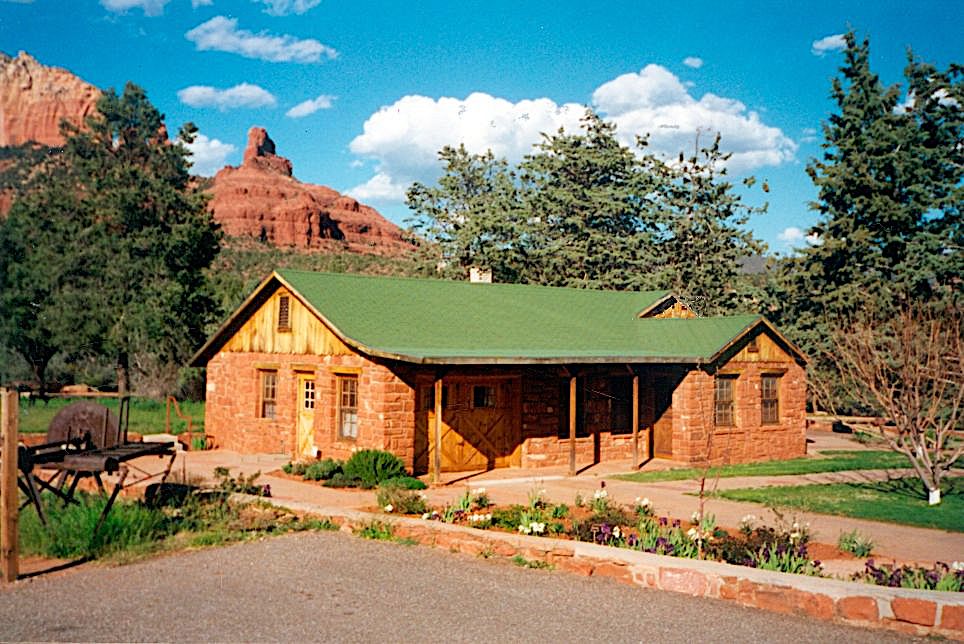 an
extensive chamber music season; and the year-round
Sedona Arts Center.
an
extensive chamber music season; and the year-round
Sedona Arts Center.
One of the more appealing sites for me was
the Sedona Heritage Museum (right) in
uptown, on the National Register of Historic
Places. It is not a modern museum with a famous
architect’s name on it—no Frank Gehry warped
titanium, no Renzo Piano walls of glass. Indeed,
the intent has been to preserve the Walter and
Ruth Jordan family’s 1931 farmstead, which Ruth
sold to the city in 1998 in order to save it from
becoming a housing development.
It is quaintly delightful. The
old rooms, kitchen, appliances and rock-faced
attached garage cover 3,000 square feet, and
inside it is packed with original artifacts that
exhibit the hard work and simple pleasures of an
Arizona farm family during and after the
Depression. There is also a 40’ x 80’ fruit
packing shed,  built in 1946, that
still houses the Jordans’ tractors and an apple
grading machine. A tenthouse was added in 2007 as
a replica of early pioneer housing whose ease of
dismantling made it a kind of mobile home.
built in 1946, that
still houses the Jordans’ tractors and an apple
grading machine. A tenthouse was added in 2007 as
a replica of early pioneer housing whose ease of
dismantling made it a kind of mobile home.
Original in its own way on the property is
a telegraph office, relocated to the Museum
grounds in 2014, that was built for the 1947 John
Wayne movie “The Angel and the Badman,” and the
inside is festooned with western movie
memorabilia.
The
old romantic road Route 66 never ran through
Sedona, and Jack Kerouac seems not to have visited
the town, but when twilight ends, standing under
the endless umbrella of stars, I thought of what
that restless traveler wrote about the vastness of
the West in his book On the Road: “The
air was soft, the stars so fine, the promise of
every cobbled alley so great, that I thought I was
in a dream.”
❖❖❖
By John Mariani
179 N 9th Street (between Bedford and Driggs)
Brooklyn
718-302-1499
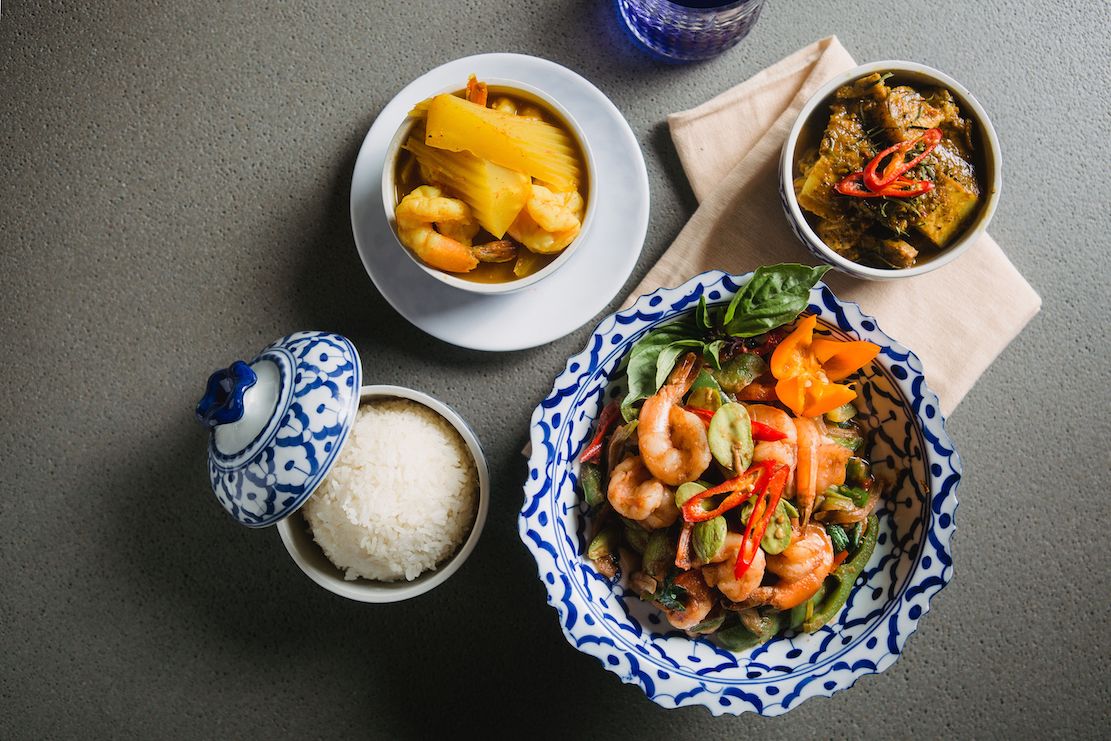
Williamsburg,
which borders the East River at the
Willamsburg Bridge, has long been a quiet
neighborhood for Hassidic Jews, but for a
while now has been gentrifying, so that
more than a couple of media articles have
referred to it as a “hipster hood.” Yet
these days it’s more of a place you’ll
find million-dollar Millennials’ condos
than hipster cafés. It’s also the home of
Brooklyn Brewery and a slew of 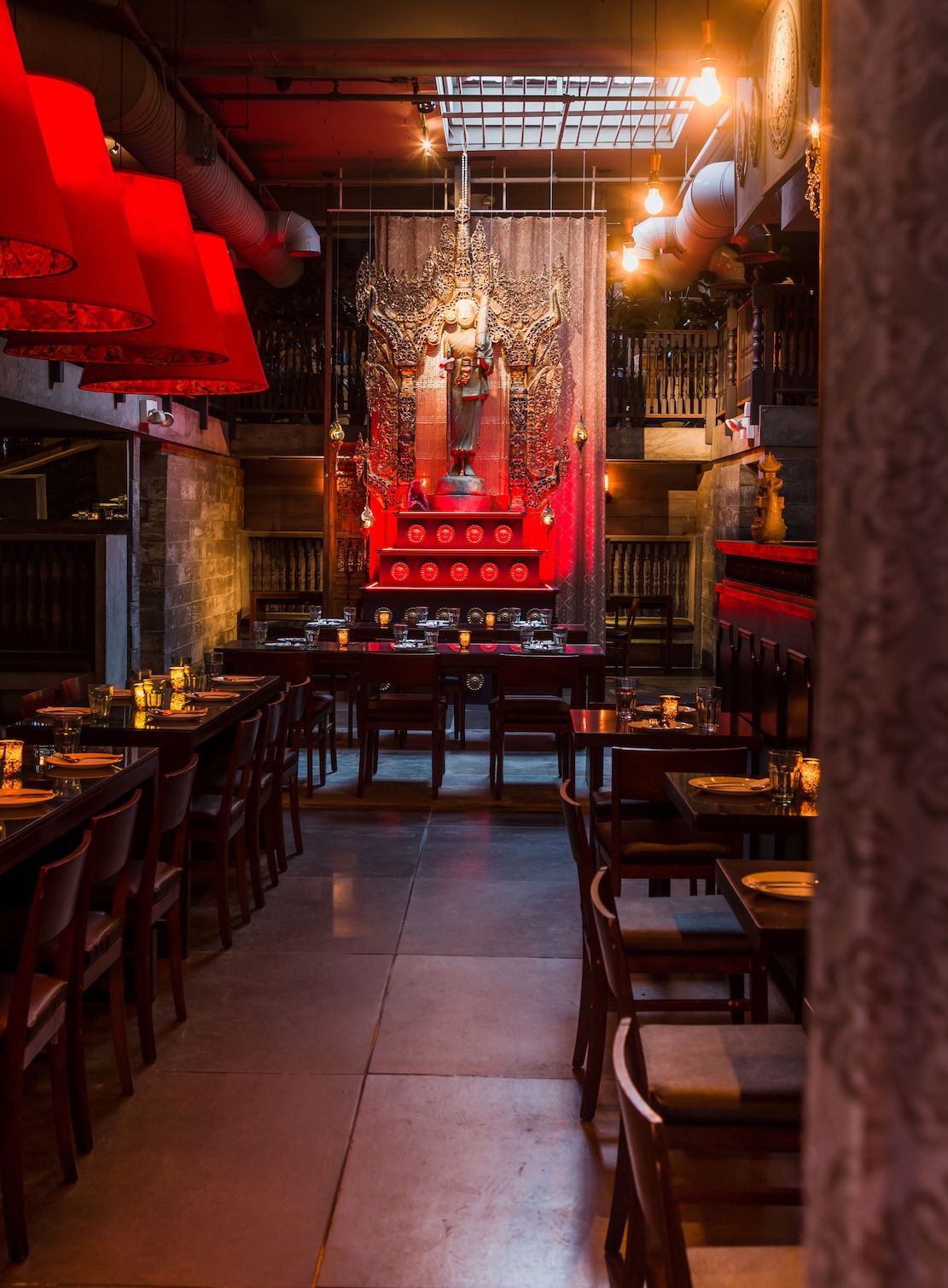 new
restaurants that join the century-old
Peter Luger Steakhouse.
new
restaurants that join the century-old
Peter Luger Steakhouse.
One of the newest is Nora Thai, whose distinction is in its divergence from the entrenched Northern Thai menus elsewhere by offering the food of Southern Thailand, from which owner Kittigron Lertpanaruk (better known as Kim Oh) emigrated to live out his American Dream. It’s certainly worked out for him: He’s built a small empire of Spice restaurants around New York, and now owns the revered Arun's in Chicago.
Nora is short for “manora,” a traditional Thai dance originating in Southern Thailand, and the 80-seat premises, once a warehouse, are theatrical indeed, with walls of reclaimed wood, intricate carvings, a handsome bar up front and a stunning large bronze statue of a fairly slender Buddha. There are plans for a DJ and live music on weekends, but for now the background music is international and a bit loud.
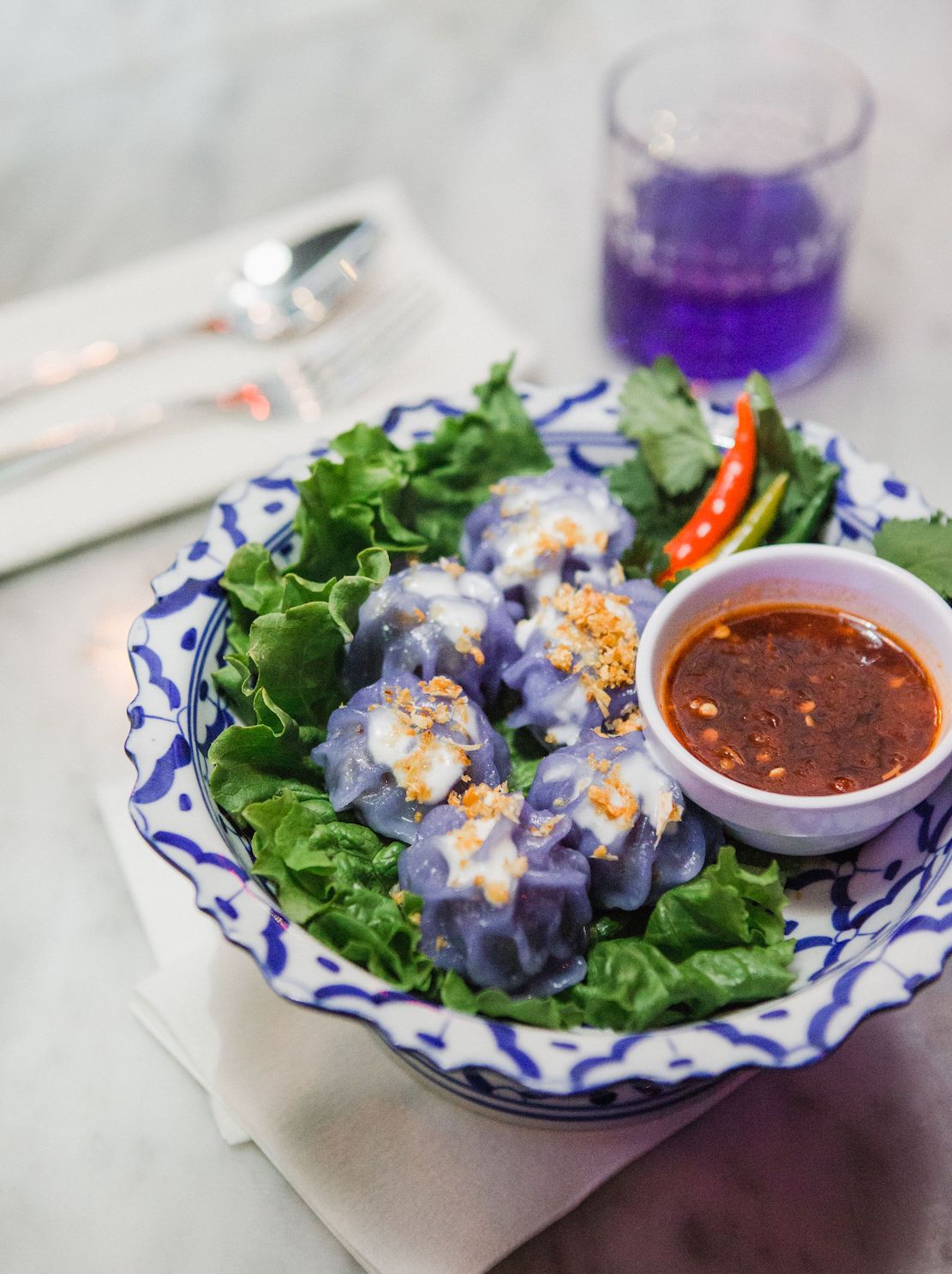 Southern
Thailand, whose principal city is Phuket, is
a long finger of land edged in by the Bay of
Thailand and the Indian Ocean, so seafood is
stressed in the region’s kitchens. Nora’s
menu is a wide and colorful palette of
seafood and meat, and the distinctions
between appetizers and main courses are
hardly noticeable.
Southern
Thailand, whose principal city is Phuket, is
a long finger of land edged in by the Bay of
Thailand and the Indian Ocean, so seafood is
stressed in the region’s kitchens. Nora’s
menu is a wide and colorful palette of
seafood and meat, and the distinctions
between appetizers and main courses are
hardly noticeable.
So
you might start with plump chicken and shrimp dumplings
with sweet and sour glaze ($8), or
chor
muang ($10), another form of blue,
flower-shaped dumplings with peas, palm
sugar and chicken (left). Or
perhaps to begin, a summer roll in an egg
wrap filled with tofu, mushrooms, bean
sprouts, sweet pork sausage and cucumber
with a tangy-sweet tamarind sauce ($8).
There’s a papaya salad called som tum
with poached shrimp, peanuts, garlic and
fish sauce ($10), as well as a green mango
salad ($9). Cua
kreang is rich in flavors of minced
pork or chicken with Thai chili, lemongrass
and shrimp paste ($14), while gaeng
som is more of a delightful spicy-sour curry with shrimp and bamboo or papaya
($14).
curry with shrimp and bamboo or papaya
($14).
Pad Thai is ubiquitous in Thai restaurants and, contrary to ill-informed belief, very popular in Thailand. Nora’s version is complex, with the flavors of sautéed rice noodles in a lime-tamarind sauce with egg, scallion, crushed peanuts and meat or tofu, along with the unusual addition of zucchini ($18).
Of six noodle dishes, I loved most the kao-soy (right) with chicken in a beautifully yellow curry with mustard greens, red onion, snow peas, lime and boiled egg topped with crispy egg noodles ($15). There are seven fried rice dishes cooked to various degrees of spiciness ($12).
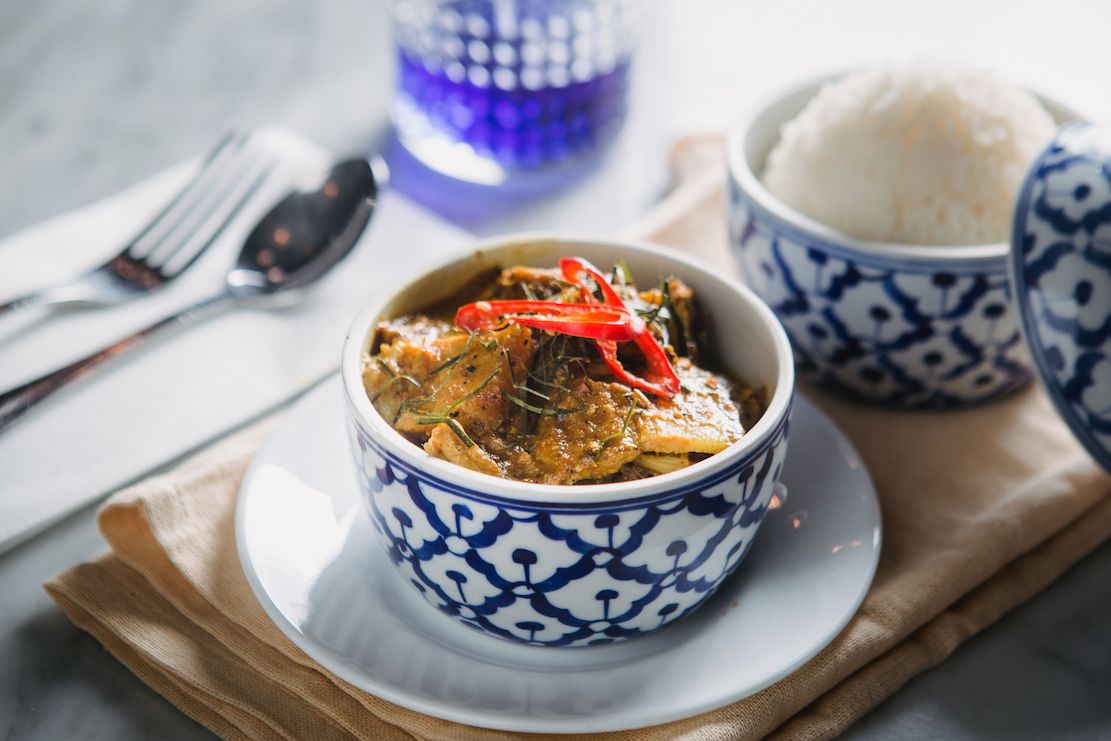 The savories go
on and on: a juicy pork chop with garlic and
Thai pepper marinade, sautéed vegetables and
a barbecue sauce ($17.50) that shows just
how overrated Sriracha is. Duck is always on
a Thai menu, and the generous half-duck with
basil and chili garlic is only $22 and feeds
two. A mango whole fish, also meant for
sharing, is a big crispy red snapper with
mango salsa, cashews and cherry tomatoes
($28).
The savories go
on and on: a juicy pork chop with garlic and
Thai pepper marinade, sautéed vegetables and
a barbecue sauce ($17.50) that shows just
how overrated Sriracha is. Duck is always on
a Thai menu, and the generous half-duck with
basil and chili garlic is only $22 and feeds
two. A mango whole fish, also meant for
sharing, is a big crispy red snapper with
mango salsa, cashews and cherry tomatoes
($28).
No matter how many dishes fill a table, there seems no end to invention, but palate fatigue simply did not occur during our long evening at Nora, because this is not a heavy cuisine. But do not miss the desserts, which are an amalgam of Thai and western flavors: Death by Chocolate Cake ($9); mango sticky rice ($9); and Thai tea panna cotta ($6).
The food is certainly the main attraction at Nora, but the place excels in its design by comparison to most Thai restaurants in the city, making it more than worth a trip over the bridge to this quiet, pleasantly gentrified neighborhood.
Open daily for lunch and dinner.
❖❖❖
By John Mariani
HOW TO BUY ALL THE HIGHLY ALLOCATED
WINES YOU WANT . . . AT A CHEAP PRICE
An Interview with Cameron Hughes
John Mariani
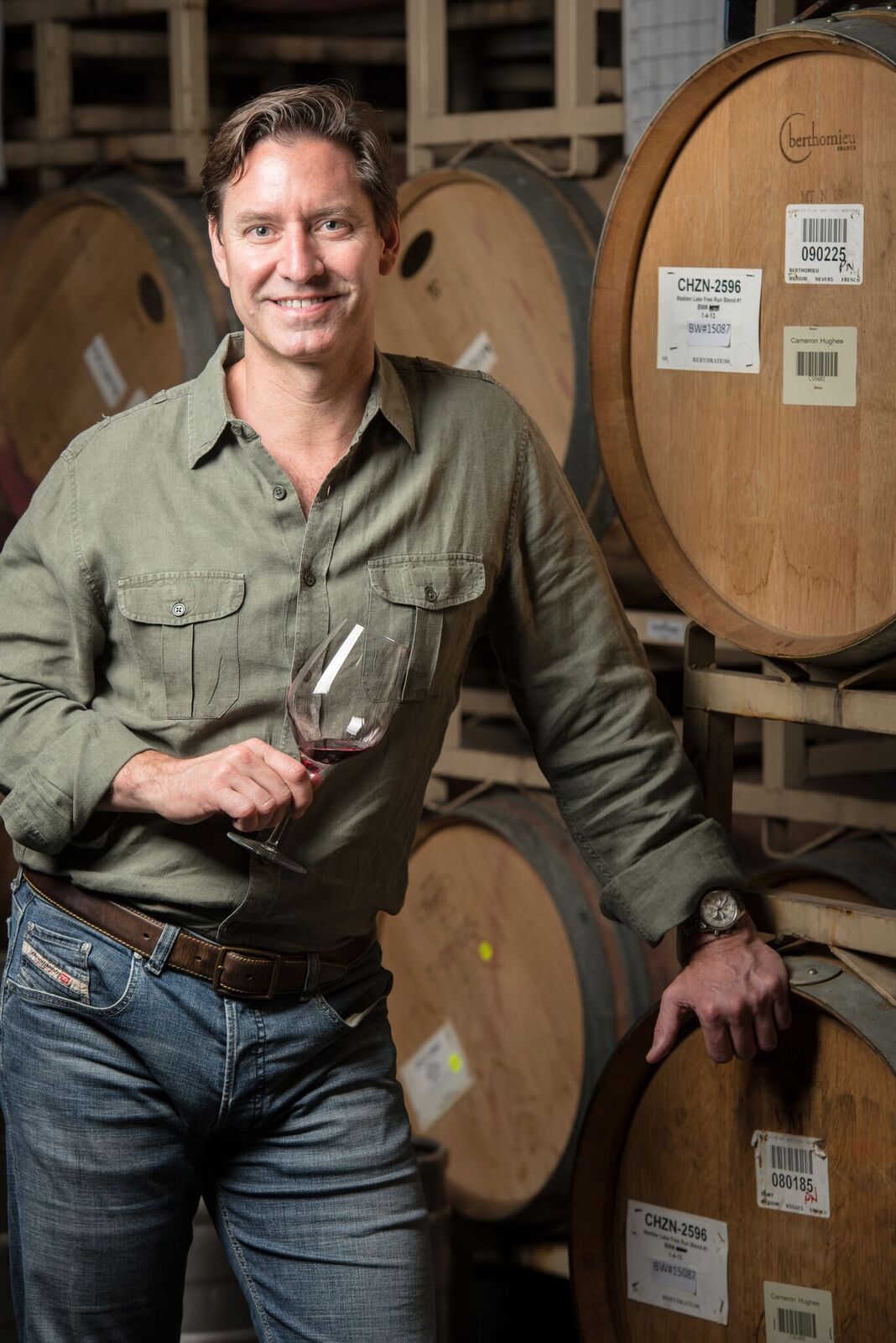
The
last time I interviewed Cameron Hughes, CEO
of the giant wine distributor under his
name, he told me about how some of most
illustrious cult wines of California, whose
bottlings win 95-point ratings from the wine
media and sell for hundreds of dollars, sell
off their excess to negoçiants like him who
in turn sell it everywhere from local wine
shops to Costco for prices below $50.
Now, after several very bountiful
vintages from 2012 to 2019, with a glut of
California wines in the market, his deals are
getting better than ever. Over
dinner in New York, the 47 year-old Hughes
told me, “The state is drowning in wine. For
wineries that pride themselves on small
production and selling only by allocation,
it’s a little embarrassing to find their
warehouses bulging with thousands of gallons
of wine. Still, they don’t want to see their
wines selling in Costco because of the
perception of lower quality.”
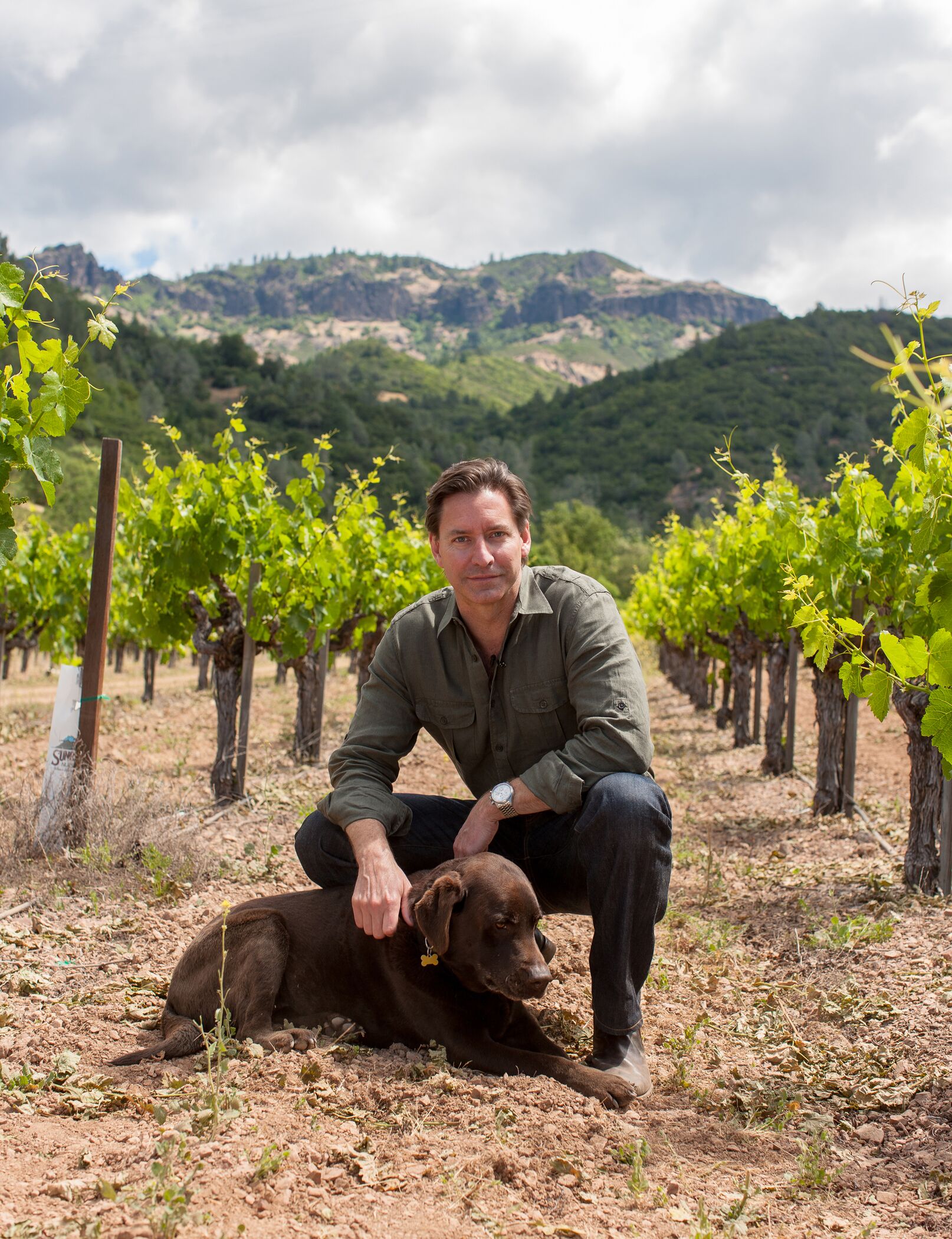 He
cited one well-known cult wine that was
selling for $65 a gallon, now available in the
market for just $20.
He
cited one well-known cult wine that was
selling for $65 a gallon, now available in the
market for just $20.
“Allocating wine is just a game,” he
said, drinking a Loire Valley Sauvignon Blanc
with a dish of foie gras. “People who buy at
the high end do so for the experience of
drinking a $300 bottle of Cabernet Sauvignon.
It’s not really about the wine itself, so the
producer says tells this wine shop owner or
restaurateur he can only get a case or a few
bottles, when in fact, his wines are stacked
up in a warehouse.”
Hughes, who lives in San Francisco and
who bears a resemblance to actor Luke Wilson,
gains tremendously from playing the game,
though he does get frustrated when he sees a
wine get a very high rating from Wine
Spectator or Wine
Advocate but a much lower one for the
same exact wine that he
sells under a different label for a quarter of
the price. He hasn’t forgotten the time a wine
was rated an “Editors Choice” with 93 points,
selling for $125. “We bought the surplus of
the same wine under our Napa Valley Lot 51
Coomsville label and sold it for $27.” In the
industry this is called a “shiner,” a wine
already bottled but without a label affixed. In
the U.S. four companies distribute 80% of the
wine sold.
The
same practices go on in Europe, where wine
laws delimit the amount of wine that may be
bottled under the French denomination
contrôlée, so that if a First Growth
Bordeaux or Grand Cru Burgundy estate enjoys
an abundant harvest, some of its finished wine
must be sold off, either under a second label
or to a négoçiant like Hughes, who labels it
himself or negotiates the sale and export of
the 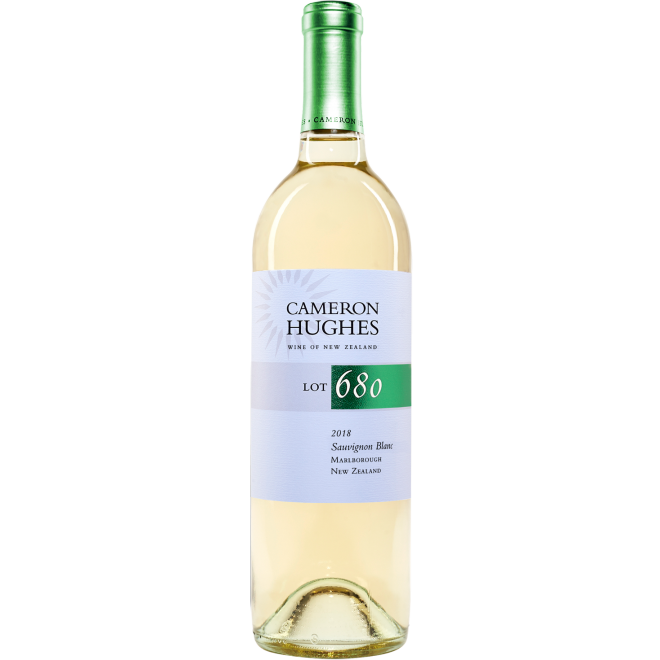 excess
wine.
Born in the Modesto, CA, wine
country, Hughes started selling his own
label—he’s never owned a vineyard—called Sinergi
Brand Kitchen Sink out
of the trunk of his car. Over the last fifteen
years he has built up an enormous range of
growers, sellers, and winery owners. He is
also now in the beef business, selling highest
quality USDA Prime and Japanese wagyu.
excess
wine.
Born in the Modesto, CA, wine
country, Hughes started selling his own
label—he’s never owned a vineyard—called Sinergi
Brand Kitchen Sink out
of the trunk of his car. Over the last fifteen
years he has built up an enormous range of
growers, sellers, and winery owners. He is
also now in the beef business, selling highest
quality USDA Prime and Japanese wagyu.
While the huge harvests of the last
decade would seem a boon to winemakers, Hughes
notes that 2019 sales will be flat, and that,
in fact, the American wine industry is bracing
for a precarious future. “It’s not so much
overproduction,” said Hughes, “but it’s more
due to Americans’ drinking habits. The boomers
have cut back on their wine consumption, while
the Gen-Xers and Millennials are more into
brown goods and beer than wine.”
Hughes’s
assertion is backed up by “The State of the
Wine Industry Report 2019” by Rob McMilland,
EVOP and Founder of the Silicon Valley Bank
Wine Division, which states that while the
baby boomers control 70 percent of U.S.
discretionary income and half the net worth in
the U.S., they “are
moving into retirement and declining in both
their numbers and per capita consumption,
[and] Millennials
aren’t yet embracing wine consumption as many
had predicted. Damaged financial capacity is a
major contributor, but cannabis legalization
is another factor explaining their slow
adoption of wine.”
 The
Report also noted that the “cumulative impact
of negative health messaging — absent
offsetting promotion of the health benefits of
moderate wine consumption — is negatively
influencing consumption, particularly for the
millennial consumer. . . . Due to many
factors, including their limited financial
capacity, a preference for premium spirits and
craft beers, delayed careers, negative health
messaging regarding alcohol, and the
legalization of cannabis, the millennial
consumer has temporarily stalled in growing
their wine consumption.”
The
Report also noted that the “cumulative impact
of negative health messaging — absent
offsetting promotion of the health benefits of
moderate wine consumption — is negatively
influencing consumption, particularly for the
millennial consumer. . . . Due to many
factors, including their limited financial
capacity, a preference for premium spirits and
craft beers, delayed careers, negative health
messaging regarding alcohol, and the
legalization of cannabis, the millennial
consumer has temporarily stalled in growing
their wine consumption.”
Hughes
is also concerned by global warming and
drought, although he notes that “grapes use less than half the
water in Central Valley – and even less in
Napa and Sonoma—but provide twice the economic
impact (efficiency) of almonds. Grapes don’t
really need a lot of water.”
He’s as concerned about what he calls
“designer yeasts” in wine, which he says may
cause warm weather wines’ alcohol levels to
rise. (It should also be mentioned that some
genetically modified yeasts have been
developed to do the opposite, by diverting
more of the grapes’ sugars to glycol rather
than alcohol, but glycol also tends to make
wines taste sweeter.)
Still, Hughes is very optimistic about
Americans’ desire to drink high quality wines
that he can supply cheaply because of the
current wine glut. It’s kind of his Kumbaya
moment: On his website, he has a video
resembling an inexpensive Super Bowl ad, with
Hughes and his dog bounding through
vineyards and a living room, plucking
wine bottles from the air and from the hands
of “the privileged, the few,” then leading a
pack of very young, smiling Millennials along
what appears to be San Francisco, . He
brandishes a bottle of his wine and exclaims,
“This
is what liberty smells like! This
is what democracy tastes like!”
It’s
not exactly Mr.
Smith Goes to Washington, but it’s
folksy, it’s catchy, it’s brimming with
youthful enthusiasm and it’s persuasive,
like
the old Coke declaring, “It’s the Real Thing!”
❖❖❖
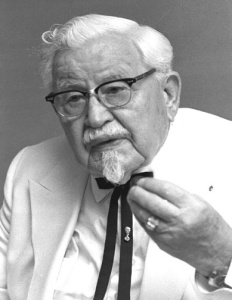
THE
COLONEL JUST TURNED OVER IN HIS
GRAVE
KFC
has announced it’s going “beyond”
fried chicken with the introduction of
a vegan imitation plant-based chicken
to its menu in Smyrna, GA, one
Atlanta-area restaurant on Tuesday.
PRECISELY THE
COMPARISON WE WOULD COME 
UP WITH. . . IF WE WERE DEAF, DUMB
AND BLIND
"Frank
Castronovo and Frank Falcinelli (the Franks) are
French-trained chefs who cook Italian. They are not,
however, pizzaioli. But they have a guy. . . Chris
Bianco of Pizzeria Bianco in Phoenix, [who] is not only a
pizzaiolo, but maybe the world’s greatest pizzaiolo. . .
. to advise and support and generally share with the
Franks all their naturally-leavened secrets. Which, if
you know anything about bread and pizza, you know is
like having John Coltrane and Charlie Parker agree to
help you play the saxophone.—"F&F Pizzeria,"
New York Magazine.
Any of John Mariani's books below may be ordered from amazon.com.
 The Hound in Heaven
(21st Century Lion Books) is a novella, and
for anyone who loves dogs, Christmas, romance,
inspiration, even the supernatural, I hope you'll find
this to be a treasured favorite. The story
concerns how, after a New England teacher, his wife and
their two daughters adopt a stray puppy found in their
barn in northern Maine, their lives seem full of promise.
But when tragedy strikes, their wonderful dog Lazarus and
the spirit of Christmas are the only things that may bring
his master back from the edge of despair.
The Hound in Heaven
(21st Century Lion Books) is a novella, and
for anyone who loves dogs, Christmas, romance,
inspiration, even the supernatural, I hope you'll find
this to be a treasured favorite. The story
concerns how, after a New England teacher, his wife and
their two daughters adopt a stray puppy found in their
barn in northern Maine, their lives seem full of promise.
But when tragedy strikes, their wonderful dog Lazarus and
the spirit of Christmas are the only things that may bring
his master back from the edge of despair. WATCH THE VIDEO!
“What a huge surprise turn this story took! I was completely stunned! I truly enjoyed this book and its message.” – Actress Ali MacGraw
“He had me at Page One. The amount of heart, human insight, soul searching, and deft literary strength that John Mariani pours into this airtight novella is vertigo-inducing. Perhaps ‘wow’ would be the best comment.” – James Dalessandro, author of Bohemian Heart and 1906.
“John Mariani’s Hound in Heaven starts with a well-painted portrayal of an American family, along with the requisite dog. A surprise event flips the action of the novel and captures us for a voyage leading to a hopeful and heart-warming message. A page turning, one sitting read, it’s the perfect antidote for the winter and promotion of holiday celebration.” – Ann Pearlman, author of The Christmas Cookie Club and A Gift for my Sister.
“John Mariani’s concise, achingly beautiful novella pulls a literary rabbit out of a hat – a mash-up of the cosmic and the intimate, the tragic and the heart-warming – a Christmas tale for all ages, and all faiths. Read it to your children, read it to yourself… but read it. Early and often. Highly recommended.” – Jay Bonansinga, New York Times bestselling author of Pinkerton’s War, The Sinking of The Eastland, and The Walking Dead: The Road To Woodbury.
“Amazing things happen when you open your heart to an animal. The Hound in Heaven delivers a powerful story of healing that is forged in the spiritual relationship between a man and his best friend. The book brings a message of hope that can enrich our images of family, love, and loss.” – Dr. Barbara Royal, author of The Royal Treatment.
 |
The Encyclopedia of American Food and Drink by John F. Mariani (Bloomsbury USA, $35) Modesty forbids me to praise my own new book, but let me proudly say that it is an extensive revision of the 4th edition that appeared more than a decade ago, before locavores, molecular cuisine, modernist cuisine, the Food Network and so much more, now included. Word origins have been completely updated, as have per capita consumption and production stats. Most important, for the first time since publication in the 1980s, the book includes more than 100 biographies of Americans who have changed the way we cook, eat and drink -- from Fannie Farmer and Julia Child to Robert Mondavi and Thomas Keller. "This book is amazing! It has entries for everything from `abalone' to `zwieback,' plus more than 500 recipes for classic American dishes and drinks."--Devra First, The Boston Globe. "Much needed in any kitchen library."--Bon Appetit. |
"Eating Italian will never be the same after reading John Mariani's entertaining and savory gastronomical history of the cuisine of Italy and how it won over appetites worldwide. . . . This book is such a tasteful narrative that it will literally make you hungry for Italian food and arouse your appetite for gastronomical history."--Don Oldenburg, USA Today. "Italian
restaurants--some good, some glitzy--far
outnumber their French rivals. Many of
these establishments are zestfully described
in How Italian Food Conquered the World, an
entertaining and fact-filled chronicle by
food-and-wine correspondent John F.
Mariani."--Aram Bakshian Jr., Wall Street
Journal.
"Equal parts
history, sociology, gastronomy, and just
plain fun, How Italian Food Conquered the
World tells the captivating and delicious
story of the (let's face it) everybody's
favorite cuisine with clarity, verve and
more than one surprise."--Colman Andrews,
editorial director of The Daily
Meal.com. "A fantastic and fascinating
read, covering everything from the influence
of Venice's spice trade to the impact of
Italian immigrants in America and the
evolution of alta cucina. This book will
serve as a terrific resource to anyone
interested in the real story of Italian
food."--Mary Ann Esposito, host of PBS-TV's
Ciao
Italia. "John Mariani has written the
definitive history of how Italians won their
way into our hearts, minds, and
stomachs. It's a story of pleasure over
pomp and taste over technique."--Danny Meyer,
owner of NYC restaurants Union Square
Cafe, The Modern, and Maialino.
|
 |
 |
 |
 |
 |
 |
 |
 |
 Everett Potter's Travel Report:
Everett Potter's Travel Report: 
 Eating Las Vegas
JOHN CURTAS has been covering the Las Vegas
food and restaurant scene since 1995. He is
the co-author of EATING LAS VEGAS – The 50
Essential Restaurants (as well as
the author of the Eating Las Vegas web site: www.eatinglasvegas.
He can also be seen every Friday morning as
the “resident foodie” for Wake Up With the
Wagners on KSNV TV (NBC) Channel 3 in
Las Vegas.
Eating Las Vegas
JOHN CURTAS has been covering the Las Vegas
food and restaurant scene since 1995. He is
the co-author of EATING LAS VEGAS – The 50
Essential Restaurants (as well as
the author of the Eating Las Vegas web site: www.eatinglasvegas.
He can also be seen every Friday morning as
the “resident foodie” for Wake Up With the
Wagners on KSNV TV (NBC) Channel 3 in
Las Vegas.
MARIANI'S VIRTUAL GOURMET
NEWSLETTER is published weekly. Publisher: John Mariani. Editor: Walter Bagley. Contributing Writers: Christopher Mariani,
Robert Mariani, Misha Mariani, John A. Curtas, Gerry Dawes, Geoff Kalish,
and Brian Freedman. Contributing
Photographer: Galina Dargery. Technical
Advisor: Gerry
McLoughlin.
If you wish to subscribe to this
newsletter, please click here: http://www.johnmariani.com/subscribe/index.html
© copyright John Mariani 2019

